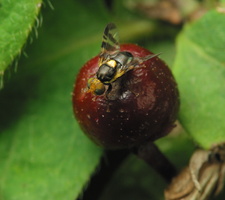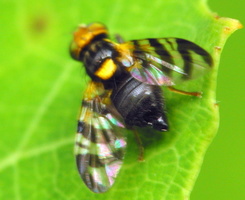- sort orderDefault
Photo title, A → Z
Photo title, Z → A
✔ Date created, new → old
Date created, old → new
Date posted, new → old
Date posted, old → new
Visits, high → low
Random
 home / Insecta · vabzdžiai / Diptera · dvisparniai / Tephritidae · margasparnės / Rhagoletis cerasi · vyšninė margasparnė
home / Insecta · vabzdžiai / Diptera · dvisparniai / Tephritidae · margasparnės / Rhagoletis cerasi · vyšninė margasparnė

Rhagoletis cerasi · vyšninė margasparnė
https://en.wikipedia.org/wiki/Rhagoletis_cerasi The adults can be found from late May to early July. They feed on the sugary secretions produced by the cherry itself or by insects (such as the aphid honeydew). After 10–15 days the females lay 50–80 eggs one at a time in the pulp of the fruit. After 6–12 days the eggs hatch and white legless larvae 4–6 mm long come out and feed on the pulp of the fruit. During the ripening the larvae leave the fruit and pupate in the soil, where they overwinter. Usually this species have one generation every 1–2 years.
These fruit flies are considered a major pest of cherry crops in Europe and Asia. They damage also the fruits of apricot, honeysuckle, barberry, bird cherry, snowberry.

